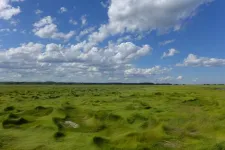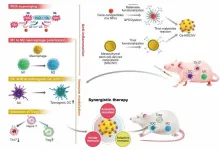(Press-News.org) PROVIDENCE, R.I. [Brown University] — Venus, a scorching wasteland of a planet according to scientists, may have once had tectonic plate movements similar to those believed to have occurred on early Earth, a new study found. The finding sets up tantalizing scenarios regarding the possibility of early life on Venus, its evolutionary past and the history of the solar system.
Writing in Nature Astronomy, a team of scientists led by Brown University researchers describes using atmospheric data from Venus and computer modeling to show that the composition of the planet’s current atmosphere and surface pressure would only have been possible as a result of an early form of plate tectonics, a process critical to life that involves multiple continental plates pushing, pulling and sliding beneath one another.
On Earth, this process intensified over billions of years, forming new continents and mountains, and leading to chemical reactions that stabilized the planet’s surface temperature, resulting in an environment more conducive to the development of life.
Venus, on the other hand, Earth’s nearest neighbor and sister planet, went in the opposite direction and today has surface temperatures hot enough to melt lead. One explanation is that the planet has always been thought to have what’s known as a “stagnant lid,” meaning its surface has only a single plate with minimal amounts of give, movement and gasses being released into the atmosphere.
The new paper posits that this wasn’t always the case. To account for the abundance of nitrogen and carbon dioxide present in Venus’ atmosphere, the researchers conclude that Venus must have had plate tectonics sometime after the planet formed, about 4.5 billion to 3.5 billion years ago. The paper suggests that this early tectonic movement, like on Earth, would have been limited in terms of the number of plates moving and in how much they shifted. It also would have been happening on Earth and Venus simultaneously.
“One of the big picture takeaways is that we very likely had two planets at the same time in the same solar system operating in a plate tectonic regime — the same mode of tectonics that allowed for the life that we see on Earth today,” said Matt Weller, the study’s lead author who completed the work while he was a postdoctoral researcher at Brown and is now at the Lunar and Planetary Institute in Houston.
This bolsters the possibility of microbial life on ancient Venus and shows that at one point the two planets — which are in the same solar neighborhood, are about the same size, and have the same mass, density and volume — were more alike than previously thought before diverging.
The work also highlights the possibility that plate tectonics on planets might just come down to timing — and therefore, so may life itself.
“We've so far thought about tectonic state in terms of a binary: it’s either true or it’s false, and it's either true or false for the duration of the planet,” said study co-author Alexander Evans, an assistant professor of Earth, environmental and planetary sciences at Brown. “This shows that planets may transition in and out of different tectonic states and that this may actually be fairly common. Earth may be the outlier. This also means we might have planets that transition in and out of habitability rather than just being continuously habitable.”
That concept will be important to consider as scientists look to understand nearby moons — like Jupiter’s Europa, which has shown proof of having Earth-like plate tectonics — and distant exoplanets, according to the paper.
The researchers initially started the work as a way to show that the atmospheres of far-off exoplanets can be powerful markers of their early histories, before deciding to investigate that point closer to home.
They used current data on Venus’ atmosphere as the endpoint for their models and started by assuming Venus has had a stagnant lid through its entire existence. Quickly, they were able to see that simulations recreating the planet’s current atmosphere didn’t match up with where the planet is now in terms of the amount nitrogen and carbon dioxide present in the current atmosphere and its resulting surface pressure.
The researchers then simulated what would have had to happen on the planet to get to where it is today. They eventually matched the numbers almost exactly when they accounted for limited tectonic movement early in Venus’ history followed by the stagnant lid model that exists today.
Overall, the team believes the work serves as a proof of concept regarding atmospheres and their ability to provide insights into the past.
“We’re still in this paradigm where we use the surfaces of planets to understand their history,” Evans said. “We really show for the first time that the atmosphere may actually be the best way to understand some of the very ancient history of planets that is often not preserved on the surface.”
Upcoming NASA DAVINCI missions, which will measure gasses in the Venusian atmosphere, may help solidify the study’s findings. In the meantime, the researchers plan to delve deep into a key question the paper raises: What happened to plate tectonics on Venus? The theory in the paper suggests that the planet ultimately became too hot and its atmosphere too thick, drying up the necessary ingredients for tectonic movement.
“Venus basically ran out of juice to some extent, and that put the brakes on the process,” said Daniel Ibarra, a professor in Brown’s Department of Earth, Environmental and Planetary Sciences and co-author on the paper.
The researchers say the details of how this happened may hold important implications for Earth.
“That’s going to be the next critical step in understanding Venus, its evolution and ultimately the fate of the Earth,” Weller said. “What conditions will force us to move in a Venus-like trajectory, and what conditions could allow the Earth to remain habitable?”
The study also included Alexandria Johnson from Purdue University. It was supported by NASA’s Solar System Workings program.
END
Venus had Earth-like plate tectonics billions of years ago, study suggests
Simulations produced by a Brown-led research team offer evidence that Venus once had plate tectonics — a finding that opens the door for the possibility of early life on the planet and insights into its history.
2023-10-26
ELSE PRESS RELEASES FROM THIS DATE:
Machine learning study looks at younger population to identify, mitigate cardiometabolic risks
2023-10-26
BINGHAMTON, N.Y. -- A researcher at Binghamton University, State University of New York will lead a $2.5 million project from the National Institutes of Health to develop machine models to identify and predict cardiometabolic risks in adolescents and young adults.
Cardiometabolic diseases are the top cause of preventable deaths worldwide, and the number of people who experience one or more of these conditions during their lifetime is increasing.
Still, much of the research about these diseases has focused on the adult and senior populations. What if younger people and the healthcare professionals who ...
Study seeks new treatments for post-traumatic stress disorder in veterans, military personnel
2023-10-26
A groundbreaking clinical trial launched October 16 will explore the promise of new drug treatments for military personnel and veterans suffering from post-traumatic stress disorder (PTSD). The multi-site trial is spearheaded by the U.S. Army Medical Materiel Development Activity (USAMMDA), part of the U.S. Army Medical Research and Development Command, and supported by a project team that includes representatives from the U.S. Air Force, Army, Navy, and Special Operations Command.
Military veterans are more likely to have PTSD than civilians, according to statistics from the U.S. Department of Veterans Affairs, and service members who deployed to ...
Scientists call for a major investigation into Congo Basin
2023-10-26
Leading researchers have launched a major scientific initiative to investigate - and help protect - the fragile Congo Basin Forest region in central Africa, one of the world’s most important but little understood ecosystems.
They say the Congo Basin Science Initiative will transform the understanding of the Congo Basin, an area of 240 million hectares of contiguous tropical forests that absorb a vast quantity of carbon, which helps to moderate the impact of global climate ...
Politecnico di Milano and Università di Milano-Bicocca awarded an ERC Synergy Grant on next-generation numerical methods for sustainability challenges
2023-10-26
Developing new-generation numerical methods for the technological challenges of the 21st century, mainly in sustainability. This is the objective underpinning NEMESIS (NEw GEneration MEthods for Numerical SImulationS), an international researchproject involving Politecnico di Milano and Università di Milano-Bicocca, which today has been awarded one of the 37 Synergy Grants by the European Research Council (ERC). ERC Synergy Grants fund research on topics that are ambitious and complex ...
Analysis finds diversity on the smallest scales in sulfur-cycling salt marsh microbes
2023-10-26
WOODS HOLE, Mass.— At the surface, salt marshes and their windswept grasses can look deceptively simple. But those marshes are teeming with biodiversity, from the insects and migrating birds in the air all the way down to the microbes that live in the soil. Scientists from the Marine Biological Laboratory (MBL) have discovered that even among the sulfur-cycling microbes that are responsible for the “rotten egg gas” smell in salt marsh air, diversity extends all the way to genomes and even to individual nucleotides.
To ...
Stunting in infancy linked to differences in cognitive and brain function
2023-10-26
Children who are too short for their age can suffer reduced cognitive ability arising from differences in brain function as early as six months of age, according to new research from the University of East Anglia.
Researchers compared the ‘visual working memory’ – the memory capacity that holds visual cues for processing – in children who had stunted growth with those having typical growth.
Published today in the journal Nature Human Behaviour, the study found that the visual ...
New nanoparticles found to be effective for the treatment of rheumatoid arthritis
2023-10-26
A team of scientists led by KOO Sagang from the Seoul National University and Center for Nanoparticle Research within the Institue for Basic Science Center (IBS), in collaboration with researchers from Korea Institute of Science and Technology (KIST) and the Seoul National University, developed a new solution for the treatment of rheumatoid arthritis (RA).
RA is a chronic disease that, unfortunately, has no cure. The disease triggers a mix of troublesome symptoms like inflamed joints, harmful cytokines, and immune system imbalances, which work together to create a relentless cycle of worsening symptoms. While targeting ...
Admissions for bronchiolitis at children’s hospitals before and during the pandemic
2023-10-26
About The Study: The results of this study of 41 large U.S. children’s hospitals suggest that bronchiolitis hospitalizations decreased transiently and then increased markedly during the COVID-19 pandemic era. Patients admitted during the pandemic era were older and were more likely to be admitted to an intensive care unit. These findings suggest that bronchiolitis seasonality has not yet returned to pre-pandemic patterns, and hospitals should prepare for the possibility of atypical timing again in 2023.
Authors: Jonathan H. Pelletier, ...
Parent-perceived benefits and harms associated with internet use by adolescent offspring
2023-10-26
About The Study: This survey study of attitudes of 1,005 parents of children and adolescents ages 9 to 15 revealed both perceived benefits (e.g., family connectedness) and concerns (e.g., cyberbullying, addiction) of internet use. Twice as many parents reported specific concerns about internet addiction than substance addiction.
Authors: Michael Peter Milham, M.D., Ph.D., of the Child Mind Institute in New York, is the corresponding author.
To access the embargoed study: Visit our For The Media website at this link https://media.jamanetwork.com/
(doi:10.1001/jamanetworkopen.2023.39851
Editor’s ...
How adults understand what kids are saying
2023-10-26
CAMBRIDGE, MA -- When babies first begin to talk, their vocabulary is very limited. Often one of the first sounds they generate is “da,” which may refer to dad, a dog, a dot, or nothing at all.
How does an adult listener make sense of this limited verbal repertoire? A new study from MIT and Harvard University researchers has found that adults’ understanding of conversational context and knowledge of mispronunciations that children commonly make are critical to the ability to understand children’s early linguistic efforts.
Using ...
LAST 30 PRESS RELEASES:
Why nail-biting, procrastination and other self-sabotaging behaviors are rooted in survival instincts
Regional variations in mechanical properties of porcine leptomeninges
Artificial empathy in therapy and healthcare: advancements in interpersonal interaction technologies
Why some brains switch gears more efficiently than others
UVA’s Jundong Li wins ICDM’S 2025 Tao Li Award for data mining, machine learning
UVA’s low-power, high-performance computer power player Mircea Stan earns National Academy of Inventors fellowship
Not playing by the rules: USU researcher explores filamentous algae dynamics in rivers
Do our body clocks influence our risk of dementia?
Anthropologists offer new evidence of bipedalism in long-debated fossil discovery
Safer receipt paper from wood
Dosage-sensitive genes suggest no whole-genome duplications in ancestral angiosperm
First ancient human herpesvirus genomes document their deep history with humans
Why Some Bacteria Survive Antibiotics and How to Stop Them - New study reveals that bacteria can survive antibiotic treatment through two fundamentally different “shutdown modes”
UCLA study links scar healing to dangerous placenta condition
CHANGE-seq-BE finds off-target changes in the genome from base editors
The Journal of Nuclear Medicine Ahead-of-Print Tip Sheet: January 2, 2026
Delayed or absent first dose of measles, mumps, and rubella vaccination
Trends in US preterm birth rates by household income and race and ethnicity
Study identifies potential biomarker linked to progression and brain inflammation in multiple sclerosis
Many mothers in Norway do not show up for postnatal check-ups
Researchers want to find out why quick clay is so unstable
Superradiant spins show teamwork at the quantum scale
Cleveland Clinic Research links tumor bacteria to immunotherapy resistance in head and neck cancer
First Editorial of 2026: Resisting AI slop
Joint ground- and space-based observations reveal Saturn-mass rogue planet
Inheritable genetic variant offers protection against blood cancer risk and progression
Pigs settled Pacific islands alongside early human voyagers
A Coral reef’s daily pulse reshapes microbes in surrounding waters
EAST Tokamak experiments exceed plasma density limit, offering new approach to fusion ignition
Groundbreaking discovery reveals Africa’s oldest cremation pyre and complex ritual practices
[Press-News.org] Venus had Earth-like plate tectonics billions of years ago, study suggestsSimulations produced by a Brown-led research team offer evidence that Venus once had plate tectonics — a finding that opens the door for the possibility of early life on the planet and insights into its history.






